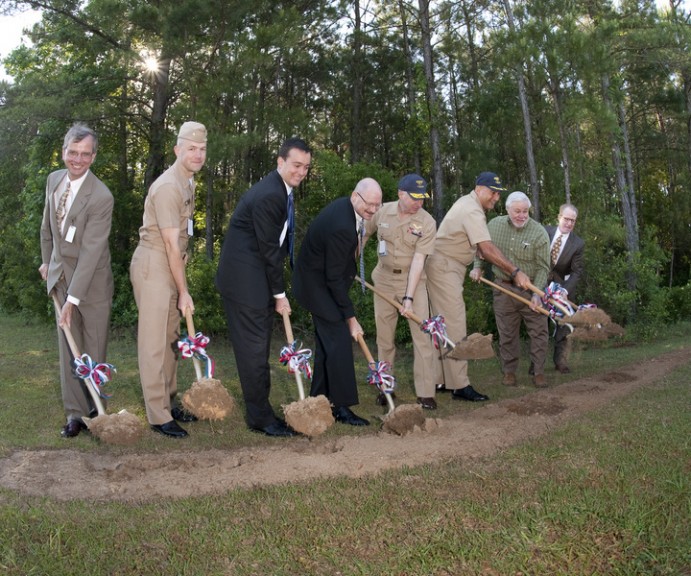
For media or press inquiries, contact:

The leaders of Space and Naval Warfare (SPAWAR) Systems Command, SPAWAR Systems Center Atlantic, local elected officials and military representatives gathered May 10 to break ground on a new, 20,220-square-foot Consolidated Engineering Laboratory.
Rear Adm. Michael Bachmann, commander of SPAWAR Systems Command; Rod Smith, deputy commander of SPAWAR Systems Command; SSC Atlantic Commanding Officer Capt. Bruce Urbon; SSC Atlantic Technical Director Christopher Miller and community leaders took shovels in hand as they broke ground for the new building during a brief ceremony held on the Southside of Naval Weapons Station, Charleston.
More than 100 people gathered for the groundbreaking at the site just north of SSC Atlantic’s existing main engineering center. Construction on the $9.49 million facility begins this fall and construction is expected to be complete by the summer of 2011.
The facility will be a hub for SSC Atlantic employees working with Service Oriented Architecture (SOA), server virtualization, cloud computing models, cyber security and defense, virtual storage, systems engineering and integration, and other state-of-the-art innovations that drive today’s information technology environment. The new facility will serve as a catalyst for the transformation of new, cutting-edge information sharing technologies that SSC Atlantic delivers to warfighters, giving them information superiority and saving lives.
“This engineering lab will provide yet another opportunity for SSC Atlantic to lead the way for change, innovation and deliver capability to our warfighters,” said Bachmann. “For Team SPAWAR, this lab represents another key element that will support the innovation we need to make best use of cyberspace for our forces,’ the admiral added.
The new facility is a critical component of the Base Realignment and Closure (BRAC) 2005 commission’s recommendation to relocate the Space and Naval Warfare Systems Center detachment in Pensacola, Fla., to Charleston. BRAC’s recommended realignments and consolidations provide for multifunctional and multidisciplinary Centers of Excellence in Maritime Command, Control, Communications, Computers, Intelligence, Surveillance and Reconnaissance (C4ISR). The overarching BRAC recommendation was to reduce from 12 to five the number of technical facilities engaged in maritime sensors, electronic warfare, electronics, cyber security and information systems Research, Development, Acquisition, Test and Evaluation (RDAT&E). This will reduce overlapping infrastructure, increase efficiency and support an integrated approach to RDAT&E for maritime C4ISR. It will also reduce cycle time for fielding systems to the warfighter. BRAC’s goal is to realize improved DoD efficiency and effectiveness through synergies and collocation.
The building will house large lab spaces and office areas. There will be 35 cubicles, each accommodating one or two people, and three offices. In the large laboratory space personnel will work on product delivery. The facility will be staffed by personnel relocating from Pensacola, as well as new hires/new positions created locally to support work requirements.
The building will be “green,” designed to the U.S. Green Building Council Leadership in Environmental and Energy Design (LEED) Silver Rating standard. Fifty percent of the construction debris will be diverted from the landfill. It will use 30 percent less water and achieve a 2 percent daylight factor. The energy usage of the building will be monitored for one year to ensure it meets ENERGY STAR requirements.
“We are dedicated to saving warfighter lives and protecting our country into the future, and the sites and sounds of construction that will emanate from this spot in the coming year will be a daily reminder of that fact,” said Urbon.
[email protected] or call us at +1 843.767.9300